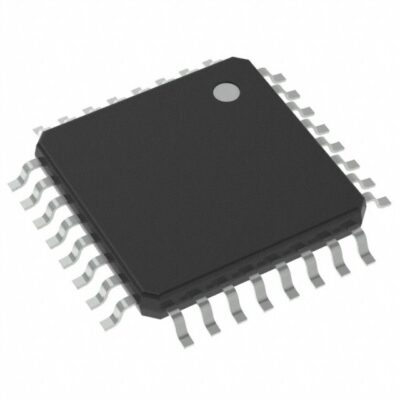ATmega88-20AU
Part Number: ATmega88-20AU
Manufacturer: Microchip Technology
Description: IC MCU 8BIT 8KB FLASH 32TQFP
Shipped from: Shenzhen/HK Warehouse
Stock Available: Check with us
ICRFQ.com - Electronic Components Distributor in China Since 2003

Part Number: ATmega88-20AU
Manufacturer: Microchip Technology
Description: IC MCU 8BIT 8KB FLASH 32TQFP
Shipped from: Shenzhen/HK Warehouse
Stock Available: Check with us
| Category | Integrated Circuits (ICs) |
|---|---|
| Family | Embedded – Microcontrollers |
| Manufacturer | Atmel |
| Series | AVR? ATmega |
| Packaging | Tray |
| Part Status | Active |
| Core Processor | AVR |
| Core Size | 8-Bit |
| Speed | 20MHz |
| Connectivity | I2C, SPI, UART/USART |
| Peripherals | Brown-out Detect/Reset, POR, PWM, WDT |
| Number of I/O | 23 |
| Program Memory Size | 8KB (4K x 16) |
| Program Memory Type | FLASH |
| EEPROM Size | 512 x 8 |
| RAM Size | 1K x 8 |
| Voltage – Supply (Vcc/Vdd) | 2.7 V ~ 5.5 V |
| Data Converters | A/D 8x10b |
| Oscillator Type | Internal |
| Operating Temperature | -40°C ~ 85°C (TA) |
| Package / Case | 32-TQFP |
| Supplier Device Package | 32-TQFP (7×7) |
AVR® improved RISC architecture is the foundation for the low-power CMOS 8-bit Atmel® ATmega48/V/ 88/V/168/V microcontroller. The ATmega48/V/88/V/168/V reaches throughputs of almost 1MIPS per MHz by processing strong instructions in a single clock cycle. This enables system designers to balance the device’s processing speed and power consumption.
The ATmega88-20AU microcontroller IC is a popular option for many applications thanks to its many features and advantages. Its sophisticated RISC architecture, which has 131 potent instructions, allows for majority of them to be executed in a single clock cycle, giving it a high processing performance of up to 20 MIPS at 20 MHz. The microcontroller’s great performance is aided by its 32 x 8 general-purpose working registers and static operation.
With up to 16K bytes of internal flash program memory that is self-programmable, 1K bytes of internal SRAM, and 512 bytes of internal EEPROM, the ATmega88-20AU microcontroller IC is well-equipped. Its high-end non-volatile memory segments ensure data preservation for up to 20 years at 85°C or 100 years at 25°C by withstanding up to 10,000 flash write/erase cycles and 100,000 EEPROM write/erase cycles. The microcontroller includes optional boot code sections with independent lock bits to provide in-system programming and actual read-while-write functionality.
one 16-bit timer or counter, Two 8-bit timer/counters, six PWM channels, and an 8-channel 10-bit ADC are among the several input/output options offered by the ATmega88-20AU microcontroller IC. In addition, the microcontroller features two master/slave SPI serial interfaces, a programmable serial USART, and a byte-oriented 2-wire serial interface that is Philips I2C compatible.
The ATmega88-20AU microcontroller IC offers a low power mode that draws about 0.1 A in power-down mode and 0.8 A in power-save mode while incorporating a 32 kHz RTC. The microcontroller supports six sleep modes: prolonged standby, power-down, power-save, ADC noise reduction, and idle.
Overall, the ATmega88-20AU microcontroller IC is a trustworthy, adaptable, user-friendly microcontroller that is compatible with a wide range of programming languages and development tools. It is a popular choice for a variety of applications, including automotive, industrial, consumer, and communication, due to its low power consumption, rapid processing speed, and varied input/output capabilities. The ATmega88-20AU data sheet and related publications are available to those who are eager for additional information.
A powerful and adaptable chip, the ATmega88-20AU microcontroller IC can be used in a variety of applications. The IC can control motors and other devices in robotics, which is one of its common applications. In industrial automation applications, the ATmega88-20AU can be used to monitor sensors and control machinery.
The ATmega88-20AU has many uses in automobile systems, including engine control units (ECUs), dashboard displays, and navigation systems. The IC is particularly suited for usage in battery-powered products such as handheld consumer electronics because of its low power consumption.
The ATmega88-20AU is also used in medical equipment, security systems, and home automation. The IC is appropriate for a variety of applications that call for precise control and monitoring because to its flexible input/output capabilities.
Overall, the ATmega88-20AU microcontroller IC is a potent and adaptable component that can be used in a wide range of applications, from consumer electronics and robotics to industrial automation and automotive systems. Developers and engineers favor it because of its quick processing, low power consumption, and numerous input/output options.
The ATmega88-20AU microcontroller IC can be interfaced with using a variety of programming languages and development tools. Among the well-liked ones are:
The ATmega88-20AU microcontroller IC is an all-around capable and adaptable component that may be used in various applications. It is simple to create apps for this microcontroller and incorporate them into different projects, thanks to the availability of various development tools and resources.
The ATmega88-20AU microcontroller IC, in conclusion, is a flexible and strong microcontroller that provides a wide range of capabilities and advantages for a variety of applications. It is suitable for use in a range of applications, including robotics, industrial automation, automotive systems, and consumer electronics, because to its low power consumption, rapid processing speed, and varied input/output capabilities. The microcontroller is simple to use and incorporate into current projects because it is compatible with a variety of programming languages and development tools. The ATmega88-20AU is unquestionably something to think about if you’re seeking for a dependable and high-performance microcontroller IC for your upcoming project.
The ATmega88-20AU microcontroller IC is just one example of the high-quality, economically cost electrical parts we provide at ICRFQ. We also provide expert assistance to help you find the parts you need. So, don’t be scared to ask our team of experts any questions you may have about this equipment. As you start your project, we are here to give you the assurance you need.
WhatsApp us